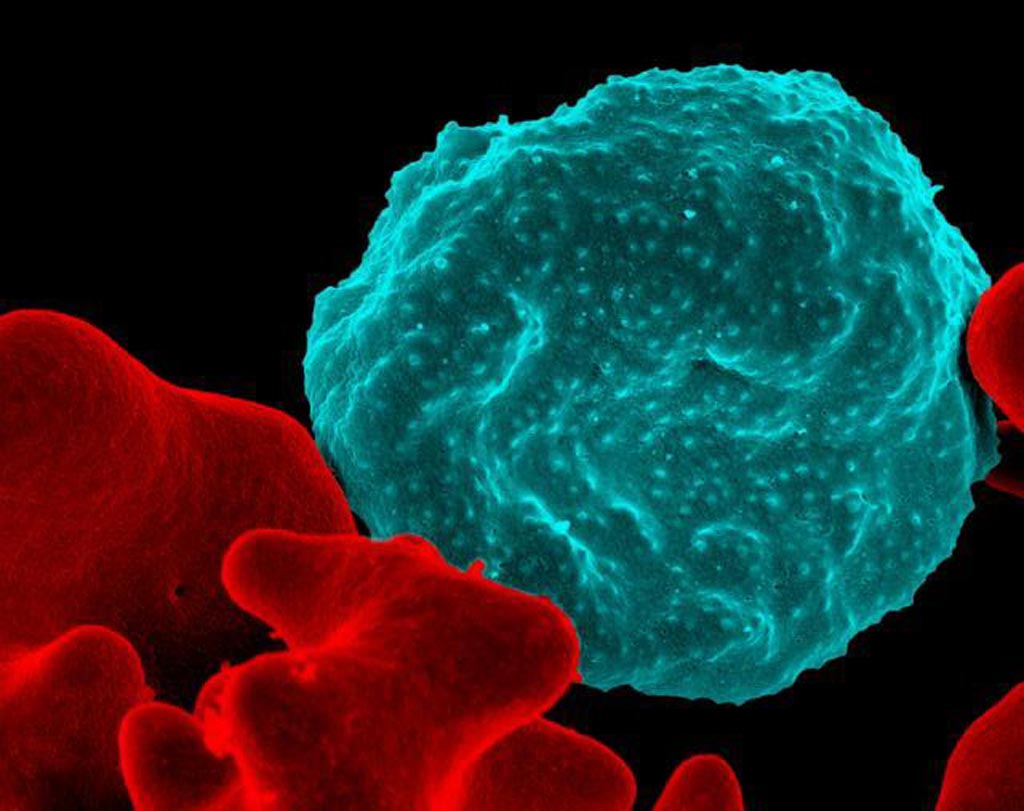PB Transposon Mutagenesis Identifies Malaria Genes and Drug Targets
By LabMedica International staff writers
Posted on 15 May 2018
A team of genome researchers took advantage of the unusual nucleotide composition of Plasmodium falciparum DNA to create mutant strains of the malaria parasite in order to identify essential genes and potential drug targets.Posted on 15 May 2018
Malaria remains a devastating global parasitic disease, with the majority of malaria deaths caused by the highly virulent P. falciparum. The extreme adenine-thymine (AT)-bias of the P. falciparum genome has hampered genetic studies through targeted approaches such as homologous recombination or CRISPR/Cas9, and only a few hundred P. falciparum mutants have been experimentally generated in the past decades.

Image: A colorized scanning electron micrograph (SEM) of a red blood cell infected with malaria parasites, which are shown in blue (Photo courtesy of the U.S. National Institute of Allergy and Infectious Diseases).
Investigators at the University of South Florida (Tampa, USA) exploited the AT-richness of the P. falciparum genome by using piggyBac transposon insertion sites to achieve saturation-level mutagenesis. The enriched A-T composition of the P. falciparum genome presented numerous piggyBac transposon insertion targets within both gene coding and noncoding flanking sequences.
PiggyBac (PB) transposons are mobile genetic elements that efficiently transpose between vectors and chromosomes via a "cut and paste" mechanism. During transposition, the PB transposase recognizes transposon-specific inverted terminal repeat sequences (ITRs) located on both ends of the transposon vector and efficiently moves the contents from the original sites and efficiently integrates them into TTAA (thymine-thymine-adenine-adenine) chromosomal sites. The powerful activity of the piggyBac transposon system enables genes of interest between the two ITRs in the PB vector to be easily mobilized into target genomes. The TTAA-specific transposon piggyBac is rapidly becoming a highly useful transposon for genetic engineering of a wide variety of species, particularly insects.
The investigators reported in the May 4, 2018, online issue of the journal Science that by using transposon mutagenesis of P. falciparum they generated more than 38,000 mutants, saturating the genome and defining mutability and fitness costs for over 87% of genes. Of 5399 genes, the study defined 2680 genes as essential for optimal growth of asexual blood stages in vitro.
Genes predicted to be essential included genes implicated in drug resistance as well as targets considered to be of high value for drugs development. Furthermore, the screen revealed essential genes that were specific to human Plasmodium parasites but absent from rodent-infective species, such as lipid metabolic genes that may be crucial to transmission commitment in human infections.
"This is a transformative advance," said senior author Dr. John H. Adams, professor of global health at the University of South Florida. "The genome of this malaria parasite has been resistant to most methods in the modern genetics toolbox. Consequently, functional importance of only a few hundred genes was determined. Using piggyBac mutagenesis, our new genetic tool, we have functionally characterized nearly all of the parasite's genes. Identifying essential genes and pathways will help guide and accelerate future drug and vaccine development."
Related Links:
University of South Florida













